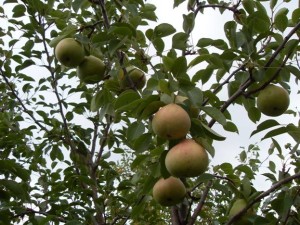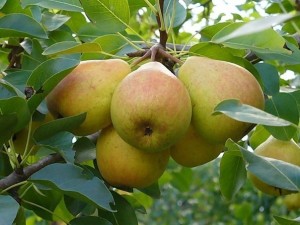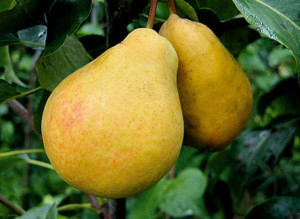Pear variety in Memory of Yakovlev - description and advantages
A group of employees of the All-Russian Research Institute of Breeding and Genetics of Fruit Plants bred a wonderful variety - the Yakovlev memory pear, by crossing such varieties as Olivier de Serre and Tema. The results of their experiments met the expectations of gardeners - this variety is very popular due to its unpretentious care, disease resistance and high yield. For many years of cultivation, only positive reviews can be heard about this pear.
Content
Description
The Yakovlev memory pear tree is fast-growing, undersized, reaching 1.5-2m in height. The crown is spherical, medium thickened, symmetrical. The bark is gray, smooth on young shoots, peeling on the trunk and skeletal branches. Branches diverge at right angles, over time, numerous annular rings are formed. Young shoots are brown in color, often have lentils and thorns. The kidneys are smooth, slightly bent, conical in shape. The foliage is dark green, leathery, ovoid with a twisted top, serrated along the edge, the petiole is 1.5-2 cm long. In the photo you can see what an adult tree and the fruits of the Yakovlev memory pear look like.

The flowers are large, white, with separate petals. Collected in inflorescences of 3-7 pieces. The fruits are large, weighing 150-200 g, with a shiny smooth skin, blunt-pear-shaped or broad-pear-shaped, light yellow or golden yellow in color. The stem is curved, up to 3-4.5 cm long. Ripens in the middle, end of September, hangs on the tree for a long time and does not crumble. The pulp is juicy, sweet, without astringency, semi-oily, white or creamy. The fruits are rich in sugars, arbutins, catechins, and various acids.
Fruiting begins as early as 4-5 years after planting. The yield increases every year and with proper care, 15-22 kg of pears can be harvested from a young 7-8 year old tree.
Advantages and disadvantages
Yakovlev's memory pear belongs to self-fertile and early-growing varieties and is a pollinator for other fruit crops. At the same time, two or three trees should be planted side by side in the garden area, this will ensure a high and stable yield, and the compactness of the crown of this variety allows you to easily place several pears in a small area.
Another important advantage of this pear is its high winter hardiness. Even young seedlings are resistant to spring frosts and sudden temperature changes. But you should take into account the low drought resistance of the plant and provide the tree with abundant and regular watering. This pear has good transportability and high resistance to scab and other common diseases of fruit crops, which greatly facilitates its cultivation.
This variety has no significant drawbacks. With abundant fruiting, with age, the presence of stone cells and some unevenness of the fruits are noted. However, with proper care and timely regular feeding, this can be avoided.

Features of cultivation
Soil and watering
The correct choice of location and planting are of great importance when growing a Yakovlev memory pear. It is not whimsical to the soil, but preference should be given to light, loamy soils with the occurrence of groundwater no higher than 1.2-1.5 m. frost.
In the first year after planting, fertilization is not required, but since Yakovlev's memory pear is not resistant to drought, it is necessary to water the tree abundantly at intervals of 20-25 days, and in a dry hot summer, keep the soil moist, but not waterlogged. If the soil is clay, then when planting, river sand, peat, compost or humus mixed in equal parts with black soil should be added. This will ensure good drainage and oxygen supply. It is recommended to plant in the aisles plants with a shallow root system, such as pumpkin, beans, peas, cabbage. This will reduce weeds and keep the root zone clean, which is also necessary for the pear for full development.

Pollinators and feeding
This variety can be planted alone, but it is recommended for better fruiting the proximity of the varieties Lada or Avgustovskaya pear, for cross-pollination. Under a biennial plant, and then annually, it is necessary to make a variety of top dressing - potassium salts, superphosphates and nitrogenous fertilizers. The first feeding is carried out before flowering, combining with abundant watering in 3-5 buckets under each tree. Then, directly during the flowering period and when ovaries with a diameter of 1.5-2.5 cm appear, the procedure is repeated.
Although the tree is resistant to many diseases, regular chemical treatments should be carried out in early spring. And also annual rejuvenating pruning, removing excess or damaged branches. Pruning is carried out before the onset of sap flow in the spring, processing the cut sites with garden pitch.
Video "Description of the pear in memory of Yakovlev"
The author of the video tells in detail about the advantages of the pear variety in Memory of Yakovlev.
